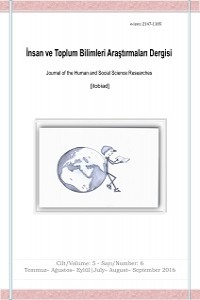Abstract
Alfabenin değiştirilmesi ile ilgili tartışmalar
Tanzimat ile başlamış, İkinci Meşrutiyet ve Cumhuriyet döneminde de devam
etmiştir. Cumhuriyetin ilan edilmesinden sonra yapılan inkılâp hareketlerinden
biri de 1 Kasım 1928’de “Türk Harflerinin Kabul ve Uygulanması Hakkında Kanun”
adıyla Latin harflerinin kabul edilmesidir.
Harf İnkılabı’ndan sonra halk, farklı yerlerde açılan yeni harf kurslarıyla
Latin harflerini tanımaya başlamıştır. Konya’da Latin Harflerinin
öğrenilmesinde ve halkın teşvik edilmesinde Babalık Gazetesi yaptığı yayın ve
haberlerle büyük bir çaba sarf etmiştir. 1 Kasım 1928 de Harf İnkılâbının kabul
edilmesinden sonra, 1 Ocak 1929’dan itibaren Millet Mekteplerinin açılmasıyla
her kesimden halkın yeni harfleri öğrenme faaliyetleri bu açılan mekteplerde
sürdürülmüş, Konya şehir merkezinde ilçe ve köylerinde kadın erkek yaşlı, genç
açılan A ve B kurslarında yeni harfleri tanıyarak Millet Mektebi diplomaları
almışlardır. Latin harflerinin tüm yurtta halka öğretilmesinde ve okuryazarlık
oranının artırılmasında katkısı yadsınamayacak Millet Mekteplerinin 1935 yılına
gelindiğinde işlerliği oldukça azalmıştır.
References
- Başbakanlık Cumhuriyet Arşivi BCA. 051-0-000-000-000-14-119-13.
- Ergün, Mustafa, Atatürk Devri Türk Eğitimi, Ankara: Ankara Üniversitesi Basımevi, 1982.
- Millet Mektepleri Talimatnamesi, Ankara: Maarif Vekâleti, 1929.
- Önder, Mehmet, Konya Maarifi Tarihi, Konya: Ülkü Basımevi, 1952.
- Turan, Refik ve Diğerleri, Atatürk İlkeleri ve İnkılap Tarihi, Ankara: Bulak Kitabevi,, 2002.
- User, Hatice Şirin, Başlangıcından Günümüze Türk Yazı Sistemleri, 1. Baskı, , İstanbul: Bilge Kültür Sanat Yayınevi, 2006.
- Ülkütaşır, M. Şakir, Atatürk Ve Harf Devrimi, 3. Baskı, Ankara: Türk Dil Kurumu Yayınları, 2000.
- Yılmaz, Mehmet Serhat, Harf İnkılâbı ve Millet Mektepleri (1928-1935) Kastamonu Örneği, Ankara: Berikan Yayınevi, 2009.
- Ülkütaşır, M. Şakir, Atatürk Ve Harf Devrimi, 3. Baskı, Ankara: Türk Dil Kurumu Yayınları, 2000.
- Yılmaz, Mehmet Serhat, Harf İnkılâbı ve Millet Mektepleri (1928-1935) Kastamonu Örneği, Ankara: Berikan Yayınevi, 2009.
- Sarısaman, Sadık, “Taşrada Harf İnkılâbının Uygulanışı (Afyonkarahisar Örneği)”, Afyonkarahisar Kocatepe Üniversitesi Sosyal Bilimler Dergisi, Cilt 8, Sayı: 3, Aralık 2006, ss. 30-36.
- Babalık Gazetesi, 12 Haziran 1928, 18 Haziran 1928, 19 Ağustos 1928, 23 Ağustos 1928, 24 Ağustos 1928, 30 Ağustos 1928, 2 Eylül 1928, 4 Eylül 1928, 11 Eylül 1928, 12 Eylül 1928, 14 Eylül 1928, 17 Eylül 1928, 20 Eylül 1928, 24 Eylül 1928, 25 Eylül 1928, 26 Eylül 1928, 24 Ekim 1928, 26 Ekim 1928, 5 Kasım 1928, 9 Kasım 1928, 12 Kasım 1928, 16 Kasım 1928, 19 Kasım 1928, 25 Kasım 1928, 28 Kasım 1928, 29 Kasım 1928, 3 Aralık 1928, 12 Aralık 1928, 16 Aralık 1928, 26 Aralık 1928, 6 Şubat 1929, 7 Şubat 1929, 6 Mart 1929, 3 Nisan 1929, 10 Mayıs 1929, 1 Ağustos 1929, 15 Ağustos 1929.
- Müezzinoğlu, Ersin, Bir İttihatçı Eğitimci Ahmet Şükrü Bey, (Yayınlanmamış Doktora Tezi), Kayseri: Erciyes Üniversitesi Sosyal Bilimler Enstitüsü,
Implementations of Letter Revolution And National Schools’ Activities For Example In Konya (1928-1935)
Abstract
Discussions about changing
the alphabet began with the Tanzimat Period (the Hatt-i Sharif of Gülhane) and
continued in the periods of second Constitutional Monarchy and Turkish
Republic. After the proclamation of the Republic, one of the reform movements
carried out was the adoption of the Latin alphabet in 1
November 1928 under the name of "Law on the Acceptance and Application of Turkish
Letters". After Arabic alphabet abandoned for such reasons as its script
itself and difficulty in learning, people began to recognize Latin alphabet
with the help of courses of the new letters in various places. The local paper
in Konya Babalık devoted a great effort in introducing and promoting the new
letters/ alphabet by making some broadcasts and news. It wasn’t until National
Schools were opened that people from all strata continued to have learning in
structions on the new alphabet, and that they received National Schools’
diploma by identifying the new letters in the A and B courses opened in the
city centre of Konya and in its towns and villages for young and old alike.
Having had undeniable contribution in teaching the Latin alphabet to the people
through out the country and thus, increasing the rate of literacy, Nation
Schools lost operability soon after the begenning of the year 1935.
References
- Başbakanlık Cumhuriyet Arşivi BCA. 051-0-000-000-000-14-119-13.
- Ergün, Mustafa, Atatürk Devri Türk Eğitimi, Ankara: Ankara Üniversitesi Basımevi, 1982.
- Millet Mektepleri Talimatnamesi, Ankara: Maarif Vekâleti, 1929.
- Önder, Mehmet, Konya Maarifi Tarihi, Konya: Ülkü Basımevi, 1952.
- Turan, Refik ve Diğerleri, Atatürk İlkeleri ve İnkılap Tarihi, Ankara: Bulak Kitabevi,, 2002.
- User, Hatice Şirin, Başlangıcından Günümüze Türk Yazı Sistemleri, 1. Baskı, , İstanbul: Bilge Kültür Sanat Yayınevi, 2006.
- Ülkütaşır, M. Şakir, Atatürk Ve Harf Devrimi, 3. Baskı, Ankara: Türk Dil Kurumu Yayınları, 2000.
- Yılmaz, Mehmet Serhat, Harf İnkılâbı ve Millet Mektepleri (1928-1935) Kastamonu Örneği, Ankara: Berikan Yayınevi, 2009.
- Ülkütaşır, M. Şakir, Atatürk Ve Harf Devrimi, 3. Baskı, Ankara: Türk Dil Kurumu Yayınları, 2000.
- Yılmaz, Mehmet Serhat, Harf İnkılâbı ve Millet Mektepleri (1928-1935) Kastamonu Örneği, Ankara: Berikan Yayınevi, 2009.
- Sarısaman, Sadık, “Taşrada Harf İnkılâbının Uygulanışı (Afyonkarahisar Örneği)”, Afyonkarahisar Kocatepe Üniversitesi Sosyal Bilimler Dergisi, Cilt 8, Sayı: 3, Aralık 2006, ss. 30-36.
- Babalık Gazetesi, 12 Haziran 1928, 18 Haziran 1928, 19 Ağustos 1928, 23 Ağustos 1928, 24 Ağustos 1928, 30 Ağustos 1928, 2 Eylül 1928, 4 Eylül 1928, 11 Eylül 1928, 12 Eylül 1928, 14 Eylül 1928, 17 Eylül 1928, 20 Eylül 1928, 24 Eylül 1928, 25 Eylül 1928, 26 Eylül 1928, 24 Ekim 1928, 26 Ekim 1928, 5 Kasım 1928, 9 Kasım 1928, 12 Kasım 1928, 16 Kasım 1928, 19 Kasım 1928, 25 Kasım 1928, 28 Kasım 1928, 29 Kasım 1928, 3 Aralık 1928, 12 Aralık 1928, 16 Aralık 1928, 26 Aralık 1928, 6 Şubat 1929, 7 Şubat 1929, 6 Mart 1929, 3 Nisan 1929, 10 Mayıs 1929, 1 Ağustos 1929, 15 Ağustos 1929.
- Müezzinoğlu, Ersin, Bir İttihatçı Eğitimci Ahmet Şükrü Bey, (Yayınlanmamış Doktora Tezi), Kayseri: Erciyes Üniversitesi Sosyal Bilimler Enstitüsü,
Details
| Journal Section | Articles |
|---|---|
| Authors | |
| Publication Date | October 21, 2016 |
| Published in Issue | Year 2016 Volume: 5 Issue: 6 |

